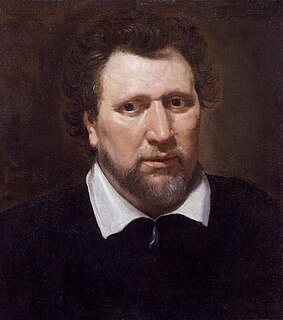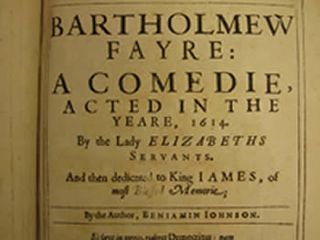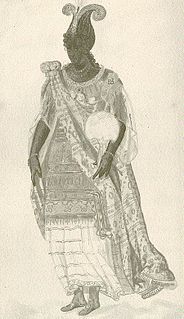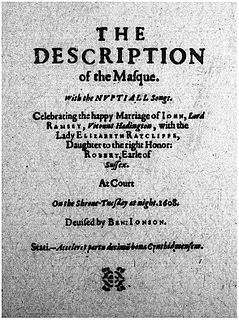Related Research Articles

Benjamin Jonson was an English playwright and poet, whose artistry exerted a lasting impact upon English poetry and stage comedy. He popularised the comedy of humours. He is best known for the satirical plays Every Man in His Humour (1598), Volpone, or The Fox, The Alchemist (1610) and Bartholomew Fair (1614) and for his lyric and epigrammatic poetry. "He is generally regarded as the second most important English dramatist, after William Shakespeare, during the reign of James I."

The London Prodigal is a play in English Renaissance theatre, a city comedy set in London, in which a prodigal son learns the error of his ways. The play was published in quarto in 1605 by the stationer Nathaniel Butter, and printed by Thomas Creede. In 1664 it was one of the seven plays that publisher Philip Chetwinde added to the second impression of his Third Folio of Shakespeare's plays.

Bartholomew Fair is a Jacobean comedy in five acts by Ben Jonson. It was first staged on 31 October 1614 at the Hope Theatre by the Lady Elizabeth's Men company. Written four years after The Alchemist, five after Epicœne, or the Silent Woman, and nine after Volpone, it is in some respects the most experimental of these plays.

The Masque of Blackness was an early Jacobean era masque, first performed at the Stuart Court in the Banqueting Hall of Whitehall Palace on Twelfth Night, 6 January 1605. It was written by Ben Jonson at the request of Anne of Denmark, the queen consort of King James I, who wished the masquers to be disguised as Africans. Anne was one of the performers in the masque along with her court ladies, all of whom appeared in black face makeup.

Hymenaei, or The Masque of Hymen, was a masque written by Ben Jonson for the marriage of Robert Devereux, 3rd Earl of Essex, and Lady Frances Howard, daughter of the Earl of Suffolk, and performed on their wedding day, 5 January 1606. The costumes, sets, and scenic effects were designed by Inigo Jones, and the music composed by Alfonso Ferrabosco.
The Magnetic Lady, or Humors Reconciled is a Caroline-era stage play, the final comedy of Ben Jonson. It was licensed for performance by Sir Henry Herbert, the Master of the Revels, on 12 October 1632, and first published in 1641, in Volume II of the second folio collection of Jonson's works.
A Tale of a Tub is a Caroline era stage play, a comedy written by Ben Jonson. The last of his plays to be staged during his lifetime, A Tale of a Tub was performed in 1633 and published in 1640 in the second folio of Jonson's works.
Love's Welcome at Bolsover is the final masque composed by Ben Jonson. It was performed on 30 July 1634, three years before the poet's death, and published in 1641.

Ben Jonson collected his plays and other writings into a book he titled The Workes of Benjamin Jonson. In 1616 it was printed in London in the form of a folio. Second and third editions of his works were published posthumously in 1640 and 1692.
Chloridia: Rites to Chloris and Her Nymphs was the final masque that Ben Jonson wrote for the Stuart Court. It was performed at Shrovetide, 22 February 1631, with costumes, sets and stage effects designed by Inigo Jones.
Oberon, the Faery Prince was a masque written by Ben Jonson, with costumes, sets and stage effects designed by Inigo Jones, and music by Alfonso Ferrabosco and Robert Johnson. Oberon saw the introduction to English Renaissance theatre of scenic techniques that became standard for dramatic productions through the coming centuries.
Love Freed from Ignorance and Folly was a Jacobean era masque, written by Ben Jonson and designed by Inigo Jones, with music by Alfonso Ferrabosco. It was performed on 3 February 1611 at Whitehall Palace, and published in 1616.

The Hue and Cry After Cupid, or A Hue and Cry After Cupid, also Lord Haddington's Masque or The Masque at Lord Haddington's Marriage, or even The Masque With the Nuptial Songs at the Lord Viscount Haddington's Marriage at Court, was a masque performed on Shrove Tuesday night, 9 February 1608, in the Banqueting House at Whitehall Palace. The work was written by Ben Jonson, with costumes, sets, and stage effects designed by Inigo Jones, and with music by Alfonso Ferrabosco — the team of creators responsible for previous and subsequent masques for the Stuart Court.
The Golden Age Restored was a Jacobean era masque, written by Ben Jonson and designed by Inigo Jones; it was performed on 1 January and 6 January 1616, almost certainly at Whitehall Palace.
The Fortunate Isles and Their Union is a Jacobean era masque, written by Ben Jonson and designed by Inigo Jones, and performed on 9 January 1625. It was the last masque acted before King James I of England, and therefore the final masque of the Jacobean era.
Neptune's Triumph for the Return of Albion was a Jacobean era masque, written by Ben Jonson, and designed by Inigo Jones. The masque is notable for the contradictory historical evidence connected with it and the confusion it caused among generations of scholars and critics.
The Masque of Augurs was a Jacobean era masque, written by Ben Jonson and designed by Inigo Jones. It was performed, most likely, on Twelfth Night, 6 January 1622.
The Weeding of the Covent Garden, or the Middlesex Justice of Peace, alternatively titled The Covent Garden Weeded, is a Caroline era stage play, a comedy written by Richard Brome that was first published in 1659. The play is a noteworthy satire on the emerging ethos of Capitalism as reflected in real estate and urban development in the early modern city.
Time Vindicated to Himself and to his Honours was a late Jacobean era masque, written by Ben Jonson and with costumes, sets, and stage effects designed by Inigo Jones. James's son and heir Prince Charles led the dances of the principal masquers, as he had in several previous masques at the Stuart Court.
News from the New World Discovered in the Moon was a Jacobean era masque, written by Ben Jonson; it was first performed before King James I on 7 January 1620, with a second performance on 29 February the same year. Jonson's text comments on significant recent developments in astronomy and journalism. The text of the masque was first published in the second folio collection of Jonson's works in 1641.
References
- ↑ James Loxley, The Complete Critical Guide to Ben Jonson, London, Routledge, 2002.
- ↑ Anthony Parr, ed., The Staple of News, Manchester, Manchester University Press, 2002; pp. 1–3.
- ↑ Richard Levin, The Multiple Plot in English Renaissance Drama. Chicago, University of Chicago Press, 1971; p. 184.
- ↑ Joad Raymond, Pamphlets and Pamphleteering in Early Modern Britain (Cambridge, 2003), ch. 4
- ↑ Parr, p. 22.
- ↑ Levin, p. 189.
- ↑ Michael Leapman, Inigo: The Troubled Life of Inigo Jones, Architect of the English Renaissance, London, Headline Book Publishing, 2003; pp. 216–17.